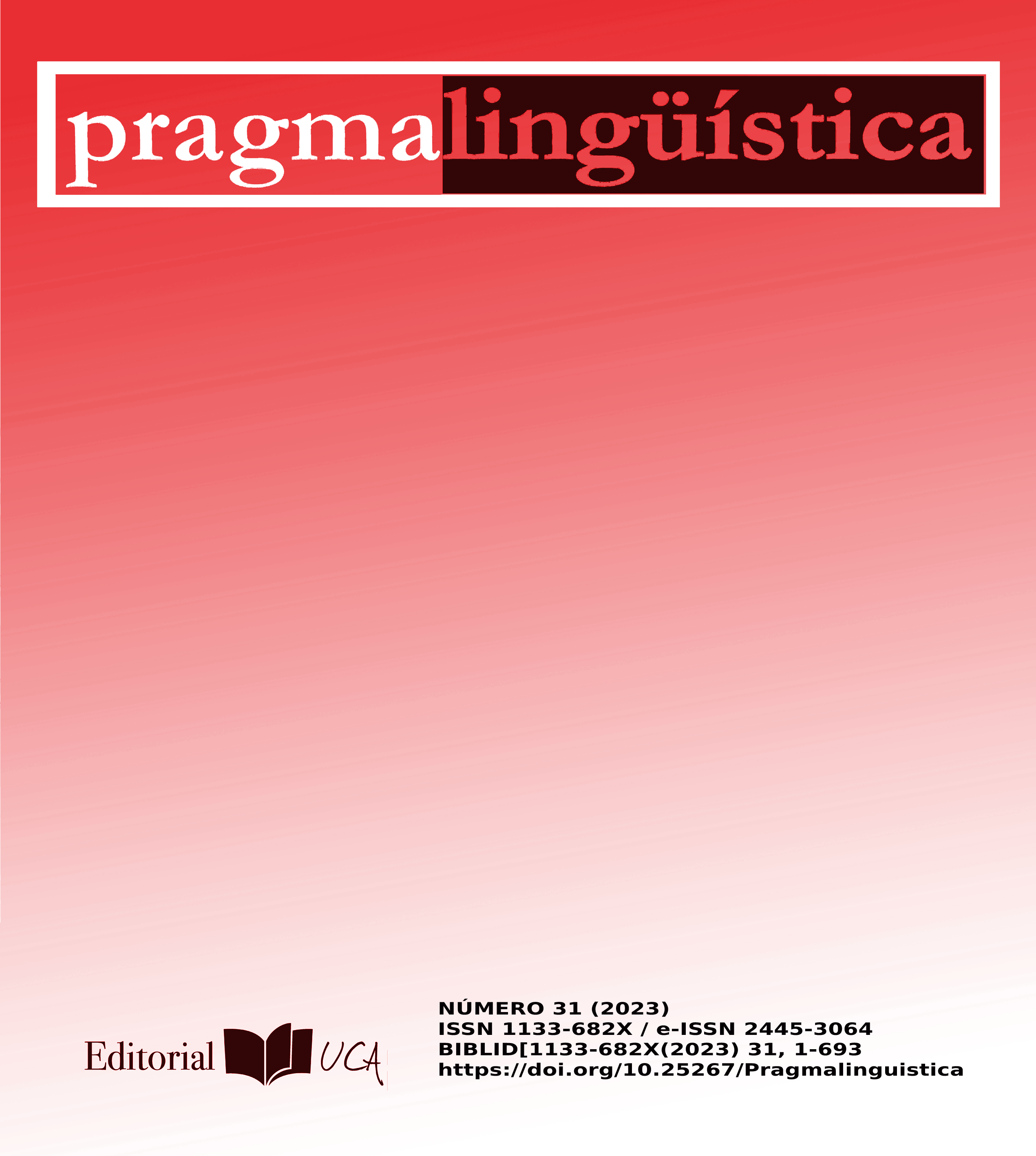Analyse du discours fictionnel à travers l'étude d'irrealia : les mondes fictionnels de Skyrim et The Witcher 3 : Wild Hunt

DOI
https://doi.org/10.25267/Pragmalinguistica.2023.i31.13Info
Résumé
Cet article vise à étudier le rôle des irrealia dans la configuration de mondes fictifs, en se concentrant sur les éventuels modèles de formation de mots d'irrealia dans les différentes catégories d'unités lexicales trouvées dans le corpus analysé, ainsi qu’à établir une nouvelle classification basée sur le degré de fictionnalité de ces unités. Pour atteindre ces objectifs, nous avons élaboré un corpus rassemblant les guides officiels de deux jeux vidéo fantastiques et épiques : The Elder Scroll V: Skyrim (2011) et The Witcher 3: Wild Hunt (2015). Grâce à l'exploration manuelle du corpus et à l'extraction individuelle des 1804 irrealia trouvées dans les deux guides, on peut conclure que, malgré les ressemblances entre les deux mondes fictionnels, nous pouvons noter des différences appréciables liées aux objectifs de chaque jeu vidéo.
Mots-clés
Téléchargements
Comment citer
Licence
(c) Tous droits réservés Sergio Martínez del Castillo 2023

Ce travail est disponible sous licence Creative Commons Attribution - Pas d'Utilisation Commerciale - Pas de Modification 4.0 International.
Références
ANYÓ, L. (2013): “Género y cultura global en el videojuego español”, Revista de Estudios Hispánicos, 1(2), pp. 247-263. https://doi.org/10.37536/preh.2013.1.2.638
BETHESDA (2011): The Elder Scrolls V: Skyrim (Microsoft Windows).
BOSQUE, I. (2015): Las categorías gramaticales. Relaciones y diferencias (2ª ed.), Madrid: Editorial Síntesis.
CARRASCO POLAINO, R. (2012): “Propuesta de tipología básica de los videojuegos de PC y consola”, ICONO 14, Revista de comunicación y tecnologías emergentes, 4(1), pp. 1-11. https://doi.org/10.7195/ri14.v4i1.398
CD PROJEKT RED (2015): The Witcher 3: Wild Hunt (Microsoft Windows).
DOLEŽEL, L. (1998): Heterocosmica: Fiction and Possible Worlds, Londres: The Johns Hopkins University Press.
ESPEZÚA SALMÓN, D. (2006): “Ficcionalidad, mundos posibles y campos de referencia”, Dialogía: revista de lingüística, literatura y cultura, 1, pp. 69-96. https://dialnet.unirioja.es/descarga/articulo/2784524.pdf (Fecha de consulta: 10/04/2021).
GENETTE, G. (1989): Palimpsestos: La literatura en segundo grado, Madrid: Altea, Taurus, Alfaguara.
GENETTE, G. (1997): Paratexts: Thresholds of interpretation, Cambridge: Press Syndicate of the University of Cambridge.
HODGSON, D. S. J., GILLILAND, L. y MUSA, A. (2015): The Witcher 3 Wild Hunt: Prima Official Game Guide, Estados Unidos: Prima Games.
HODGSON, D. S. J. y STRATTON, S. (2011): The Elder Scrolls V Skyrim: Prima Official Game Guide, Estados Unidos: Prima Games.
JIMÉNEZ ALCÁZAR, J. F. (2016): De la Edad de los Imperios a la Guerra Total: Medievo y videojuegos, Murcia: Compobell.
MARTÍNEZ MARTÍNEZ, I. (2018): “Lingüística de corpus y gramática inductiva: una aproximación”, Tonos digital, 35, pp. 1-20. https://digitum.um.es/digitum/bitstream/10201/60522/1/2004-5699-1-PB.pdf (Fecha de consulta: 22/04/2021).
MORENO PAZ, M. C. y RODRÍGUEZ-TAPIA, S. (2018): “El discurso ficcional y los irrealia: tipos de conocimiento sobre la realidad y sus actualizaciones lingüísticas a través del léxico”, Pragmalingüística, 26, pp. 221-245. https://doi.org/10.25267/Pragmalinguistica.2018.i26
MORENO PAZ, M. C. (2019a): La traducción de los particulares ficcionales en la literatura fantástica: los irrealia en la obra de J. R. R. Tolkien y su traducción en las versiones en francés y en español (Tesis doctoral. Universidad de Córdoba). http://helvia.uco.es:8080/handle/10396/19086 (Fecha de consulta: 27/03/2021).
MORENO PAZ, M. C. (2019b): “Los irrealia en The Lord of the Rings de J. R. R. Tolkien y su traducción al español: procedimientos de formación y su recurrencia y productividad”, Skopos, 10, pp. 133-159. https://doi.org/10.21071/skopos.v10i.12316
NEWMAN, J. (2004): Videogames, Londres: Routledge.
PARODI, G. (2008): “Lingüística de corpus: una introducción al ámbito”, Revista de Lingüística Teórica y Aplicada, 46(1), pp. 93-119. https://doi.org/10.4067/S0718-48832008000100006
PÉREZ FERNÁNDEZ, L. M. (2010): La localización de videojuegos (inglés-español): aspectos técnicos, metodológicos y profesionales. Tesis doctoral. Universidad de Málaga. http://hdl.handle.net/10630/4040 (Fecha de consulta: 23/03/2021).
RODRÍGUEZ-TAPIA, S. (2017): “Los peritextos narrativos del videojuego cyberpunk: Diversidad tipológica textual a partir de un análisis microestructural del caso Deus Ex: Human RevolutionTM”, Tonos digital, 33, pp. 1-26. http://www.tonosdigital.es/ojs/index.php/tonos/article/view/1764/942 (Fecha de consulta: 30/03/2021).
RODRÍGUEZ-TAPIA, S. y MORENO PAZ, M. C. (2018): “El conocimiento ficcional como forma de acercamiento al conocimiento del mundo real: reclasificación de los tipos de conocimiento, caracterización y fundamentos para un enfoque lingüístico”, Hikma, 17, pp. 145-173. https://doi.org/10.21071/hikma.v17i0.11153
WOLFE, G. K. (2011): Evaporating Genres: essay on fantastic literature, Middletown: Wesleyan University Press.
YUSTE FRÍAS, J. (2011): “Traducir para la pantalla: el traductor entre el texto y la imagen”, Di Giovanni, E. (ed.), Diálogos intertextuales 5: Between Text and Receiver: Translation and Accessibility. Entre texto y receptor: traducción y accesibilidad, Frankfurt am Main: Peter Lang, pp. 57-88.






